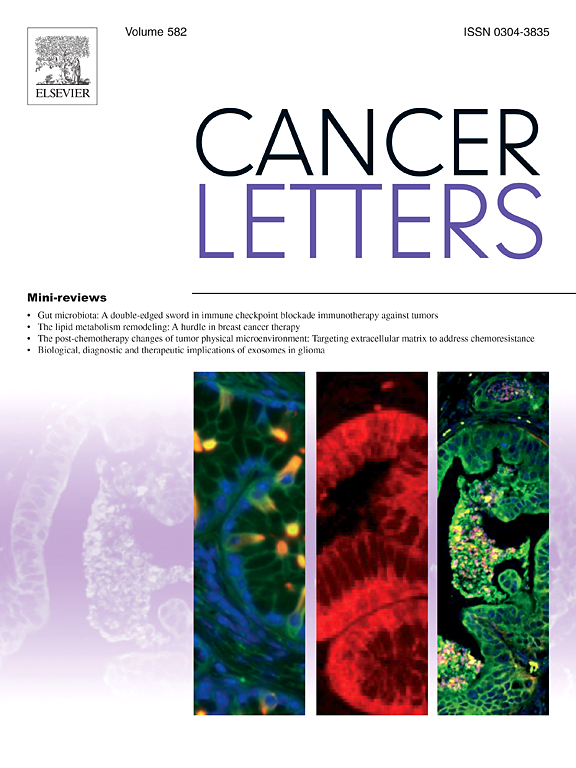核因子 I/B:癌症病理生理学中的双重作用。
IF 9.1
1区 医学
Q1 ONCOLOGY
引用次数: 0
摘要
核因子 I(NFI)转录因子家族在器官发育和成熟过程中起着决定性作用。它们的失调与多种疾病,尤其是癌症有关。NFIB 与其他 NFI 家族成员不同,它具有驱动肿瘤抑制程序和致癌程序的独特能力。因此,失调的 NFIB 信号传导对癌症的最终影响具有特异性,并受到上游调节因子和下游效应因子复杂网络的强烈影响。破译驱动 NFIB 在癌症特异性网络中发挥矛盾作用的事件,不仅能让我们了解这一关键转录因子如何发挥其双重作用,还能推动创新,帮助我们在不同癌症中有效地靶向 NFIB。在此,我们将对 NFIB 进行深入综述。我们从 NFIB 在各种器官(尤其是中枢神经系统)的发育过程中所起的决定性作用入手,强调了其关键的信号通路以及失调对肿瘤转化的影响,并将其与单独沉默的效果进行了对比。然后,我们举例说明了它在各种癌症中的双重作用,确定了与致癌和抑制肿瘤相关的特定信号网络。我们以骨肉瘤这一癌症类型为例,说明 NFIB 在其中发挥的双重作用,并探讨影响每种功能的途径。通过这种方式,我们提出了在 NFIB 失调的情况下,从具有共同触发事件的癌症中进行角色转换的合理机制。我们还回顾了 NFIB 如何通过驱动转移、干性和化疗抗性来增强侵袭性。最后,我们讨论了靶向 NFIB 的有效方法,并提出了一些未解答的问题,这些问题可能有助于进一步巩固我们对 NFIB 的理解,并促进 NFIB 靶向的临床转化。本文章由计算机程序翻译,如有差异,请以英文原文为准。
Nuclear factor I/B: Duality in action in cancer pathophysiology
The nuclear factor I (NFI) family of transcription factors plays a decisive role in organ development and maturation. Their deregulation has been linked with various diseases, most notably cancer. NFIB stands apart from the other NFI family members given its unique ability to drive both tumor suppressive and oncogenic programs. Thus, the ultimate impact of deregulated NFIB signaling is cancer-specific and strongly influenced by an intricate network of upstream regulators and downstream effectors. Deciphering the events that drive NFIB's paradoxical roles within these networks will enable us to not only understand how this critical transcription factor enacts its dual roles but also drive innovations to help us effectively target NFIB in different cancers. Here, we provide an in-depth review of NFIB. Starting with its defining role in the development of various organs, most notably the central nervous system, we highlight critical signaling pathways and the impact of deregulation on neoplastic transformation, contrasting it with the effect of silencing alone. We then provide examples of its dual roles in various cancers, identifying specific signaling networks associated with oncogenesis versus tumor suppression. We incorporate an example of a cancer type, osteosarcoma, wherein NFIB enacts its dual functions and explore which pathways influence each function. In this manner, we suggest plausible mechanisms for its role-switching from cancers sharing common triggering events in the setting of NFIB deregulation. We also review how NFIB enhances aggressiveness by driving metastasis, stemness, and chemoresistance. We conclude with a discussion on efficacious ways to target NFIB and pose some unanswered questions that may further help solidify our understanding of NFIB and facilitate clinical translation of NFIB targeting.
求助全文
通过发布文献求助,成功后即可免费获取论文全文。
去求助
来源期刊

Cancer letters
医学-肿瘤学
CiteScore
17.70
自引率
2.10%
发文量
427
审稿时长
15 days
期刊介绍:
Cancer Letters is a reputable international journal that serves as a platform for significant and original contributions in cancer research. The journal welcomes both full-length articles and Mini Reviews in the wide-ranging field of basic and translational oncology. Furthermore, it frequently presents Special Issues that shed light on current and topical areas in cancer research.
Cancer Letters is highly interested in various fundamental aspects that can cater to a diverse readership. These areas include the molecular genetics and cell biology of cancer, radiation biology, molecular pathology, hormones and cancer, viral oncology, metastasis, and chemoprevention. The journal actively focuses on experimental therapeutics, particularly the advancement of targeted therapies for personalized cancer medicine, such as metronomic chemotherapy.
By publishing groundbreaking research and promoting advancements in cancer treatments, Cancer Letters aims to actively contribute to the fight against cancer and the improvement of patient outcomes.
 求助内容:
求助内容: 应助结果提醒方式:
应助结果提醒方式:


